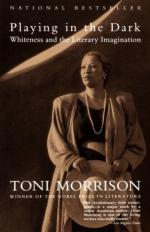
|
| Name: _________________________ | Period: ___________________ |
This test consists of 5 multiple choice questions, 5 short answer questions, and 10 short essay questions.
Multiple Choice Questions
1. Who gave the lectures that Morrison bases Playing in the Dark on?
(a) Wexley Moth.
(b) William Massey.
(c) Westley Morford.
(d) Willard Mast.
2. What does Morrison claim that critics do not say about Sapphira and the Slave Girl?
(a) Why it is a failure.
(b) Why people read it.
(c) Why it was written.
(d) Why it is successful.
3. For Morrison, when a writer is challenged and activities are more difficult, what else do they become?
(a) Less significant.
(b) More exciting.
(c) More rewarding.
(d) Less valuable.
4. In what role does Morrison describe herself as assuming nothing happens?
(a) European.
(b) Reader.
(c) Writer.
(d) Black woman.
5. In what role does Morrison see the subject of a dream?
(a) Artist.
(b) Black woman.
(c) Reader.
(d) Writer.
Short Answer Questions
1. Where were the lectures that Playing in the Dark is based on given?
2. Where does Morrison claim to apply the knowledge in Playing in the Dark?
3. What does Morrison wish studies of racism would focus on?
4. In the attack on Algeria, what does Cardinal see?
5. What does Morrison's work require her to consider?
Short Essay Questions
1. What does Morrison say Sapphira and the Slave Girl is an example of?
2. What does the term Africanism mean?
3. Who does Morrison blame for literary whiteness and blackness?
4. Describe Morrison's statement that the subject of the dream is the dreamer.
5. According to Morrison, what does a black woman represent to literature but not to herself?
6. Describe the dichotomies Morrison presents as being necessary for black people to fulfill.
7. What does it mean when Morrison says that her vulnerability lies in romanticizing blackness?
8. To Morrison, why are reading and writing not extremely distinct for a writer?
9. Which authors does Morrison describe as using black references in their work?
10. What are the prevalent themes in Sapphira and the Slave Girl?
|
This section contains 791 words (approx. 3 pages at 300 words per page) |

|




